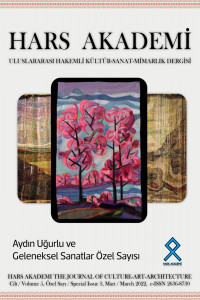Öz
The tradition of preparing a dowry begins with the birth of a girl in Anatolian culture and continues until the day she gets married. The phrase “girl in a cradle, dowry in chest” is also widely used among the people and describes this tradition in the best way. In general, a young girl’s dowry includes various textiles that she will need in her daily life, such as kitchen utensils, bedding, quilts, various covers, carpet and flat weaving mats, pillows, cushions, sacks and saddlebags. The items prepared as this dowry differ depending on the economic situation of the family and at the same time contain some changes depending on the local traditions and customs. Each family completes the dowry preparation in line with their own financial means and the oral tradition of the environment they live in. Although there are differences, weavings are the leading dowry items in almost every region of Anatolia. However, although the factors such as developing technology, changing living conditions and fashion cause changes in the tradition of dowry preparation and the goods in the dowry, dowry preparation is tried to be continued as a cultural value in many regions. In this study, it is aimed to determine the types of weavings in the dowry of young girls who have reached the age of marriage in the Mucur region, according to their intended use, and to document and introduce these weavings by examining them in terms of size, color, motif and pattern features. As a result of the examination, it was determined that the 6 piece carpet pillow set was the priority in the dowry tradition of the region and that the wall rugs, sacks and haral weavings were common.
Kaynakça
- Akyürek, N. Metin; Köksal, Ahmet Aydın; Yıldırım, M. Murat (1997). Tarihten Günümüze Mucur. Ankara: Güney Repro Matbaacılık Basım Yayın.
- Artun, Erman (2014). Halkbilimi/ Halk Edebiyatı Sözlüğü. Karahan Kitabevi.
- Cihan, Avşar (1990). Kırşehir ve İlçeleri. Ankara: Özgün Matbaacılık Sanayi.
- Deniz, Bekir (2000). Türk Dünyasında Halı ve Düz Dokuma Yaygılar. Ankara: Atatürk Kültür Merkezi Yayınları.
- Etikan, Sema; Ölmez, Filiz N.; Kılıçarslan, Hande (2020a). Kırşehir Halıları, (Ed. Aysen Soysaldı), Cumhuriyet Dönemi Türk Halıcılığı Kitabı, Cilt: 2, Ankara: Atatürk Kültür Merkezi Başkanlığı, s. 1067-1106.
- Etikan, Sema; Ölmez, Filiz N.; Kılıçarslan, Hande; Şahin, Cenk (2020b). Kırşehir El Sanatları, (1. Baskı). Ankara: Gece Kitaplığı Yayınları.
- Etikan, Sema; Ölmez, Filiz N.; Kılıçarslan, Hande; Şahin, Cenk (2021a). “Mucur Yöresi Halı Yastıkları”. XV. Uluslararası Türk Kültürü Sanatı ve Kültürel Mirası Koruma Çevrimiçi Sempozyumu- Sanat Etkinlikleri. 12-14 Nisan. ADÜ Yayın No: 76.
- Etikan, Sema; Ölmez, Filiz N.; Kılıçarslan, Hande; Şahin, Cenk (2021b). “Mucur Yöresi Dalakçı Kilimleri”. 15. Uluslararası Türk Sanatı, Tarihi ve Folkloru Çevrimiçi Kongresi/ Sanat Etkinlikleri. 21-23 Haziran. ADÜ Yayın No: 77.
- Hasol, Doğan (1979). “Mihrap Maddesi”. Ansiklopedik Mimarlık Sözlüğü.
- Nekrasova, N.P.; Kınayeva, K.G. (1997). Moskova Şark Sanatları Devlet Müzesi Türk, Azeri ve Türkmen Seccadeleri. Atatürk Yüksek Kurumu, Atatürk Kültür Merkezi Başkanlığı.
- Ölçer, Nazan (1988). Türk ve İslam Eserleri Müzesi, Kilimler. İstanbul: Eren Yayıncılık Ltd. Şti. Ölmez, Filiz N. (2012). Ölüm Olgusunun Türk Dokumalarına Yansıması- Defin. (Ed. Emine Gürsoy NASKALİ,). Tarihçi Kitabevi.
- Ölmez, Filiz N.; Etikan, Sema; Kılıçarslan, Hande; Şahin, Cenk (2021). Kırşehir Özbağ Kirkitli Dokumaları. Ankara: Gece Kitaplığı Yayınları.
- Paquin, Gerard, A. (1983). “The Iconography of Everyday Life in Nineteenth Century Middle Eastern Rugs”, The Textile Museum Journal, Vol: 22, s. 5-18.
- Şahin, Hasan (2006). Geçmişten Bugüne Mucur ve Köyleri, Ankara.
Öz
Kaynakça
- Akyürek, N. Metin; Köksal, Ahmet Aydın; Yıldırım, M. Murat (1997). Tarihten Günümüze Mucur. Ankara: Güney Repro Matbaacılık Basım Yayın.
- Artun, Erman (2014). Halkbilimi/ Halk Edebiyatı Sözlüğü. Karahan Kitabevi.
- Cihan, Avşar (1990). Kırşehir ve İlçeleri. Ankara: Özgün Matbaacılık Sanayi.
- Deniz, Bekir (2000). Türk Dünyasında Halı ve Düz Dokuma Yaygılar. Ankara: Atatürk Kültür Merkezi Yayınları.
- Etikan, Sema; Ölmez, Filiz N.; Kılıçarslan, Hande (2020a). Kırşehir Halıları, (Ed. Aysen Soysaldı), Cumhuriyet Dönemi Türk Halıcılığı Kitabı, Cilt: 2, Ankara: Atatürk Kültür Merkezi Başkanlığı, s. 1067-1106.
- Etikan, Sema; Ölmez, Filiz N.; Kılıçarslan, Hande; Şahin, Cenk (2020b). Kırşehir El Sanatları, (1. Baskı). Ankara: Gece Kitaplığı Yayınları.
- Etikan, Sema; Ölmez, Filiz N.; Kılıçarslan, Hande; Şahin, Cenk (2021a). “Mucur Yöresi Halı Yastıkları”. XV. Uluslararası Türk Kültürü Sanatı ve Kültürel Mirası Koruma Çevrimiçi Sempozyumu- Sanat Etkinlikleri. 12-14 Nisan. ADÜ Yayın No: 76.
- Etikan, Sema; Ölmez, Filiz N.; Kılıçarslan, Hande; Şahin, Cenk (2021b). “Mucur Yöresi Dalakçı Kilimleri”. 15. Uluslararası Türk Sanatı, Tarihi ve Folkloru Çevrimiçi Kongresi/ Sanat Etkinlikleri. 21-23 Haziran. ADÜ Yayın No: 77.
- Hasol, Doğan (1979). “Mihrap Maddesi”. Ansiklopedik Mimarlık Sözlüğü.
- Nekrasova, N.P.; Kınayeva, K.G. (1997). Moskova Şark Sanatları Devlet Müzesi Türk, Azeri ve Türkmen Seccadeleri. Atatürk Yüksek Kurumu, Atatürk Kültür Merkezi Başkanlığı.
- Ölçer, Nazan (1988). Türk ve İslam Eserleri Müzesi, Kilimler. İstanbul: Eren Yayıncılık Ltd. Şti. Ölmez, Filiz N. (2012). Ölüm Olgusunun Türk Dokumalarına Yansıması- Defin. (Ed. Emine Gürsoy NASKALİ,). Tarihçi Kitabevi.
- Ölmez, Filiz N.; Etikan, Sema; Kılıçarslan, Hande; Şahin, Cenk (2021). Kırşehir Özbağ Kirkitli Dokumaları. Ankara: Gece Kitaplığı Yayınları.
- Paquin, Gerard, A. (1983). “The Iconography of Everyday Life in Nineteenth Century Middle Eastern Rugs”, The Textile Museum Journal, Vol: 22, s. 5-18.
- Şahin, Hasan (2006). Geçmişten Bugüne Mucur ve Köyleri, Ankara.
Ayrıntılar
| Birincil Dil | Türkçe |
|---|---|
| Bölüm | MAKALELER |
| Yazarlar | |
| Yayımlanma Tarihi | 31 Mart 2022 |
| Yayımlandığı Sayı | Yıl 2022 Cilt: 5 Sayı: Özel Sayı 3 - AYDIN UĞURLU VE GELENEKSEL SANATLAR ÖZEL SAYISI |


